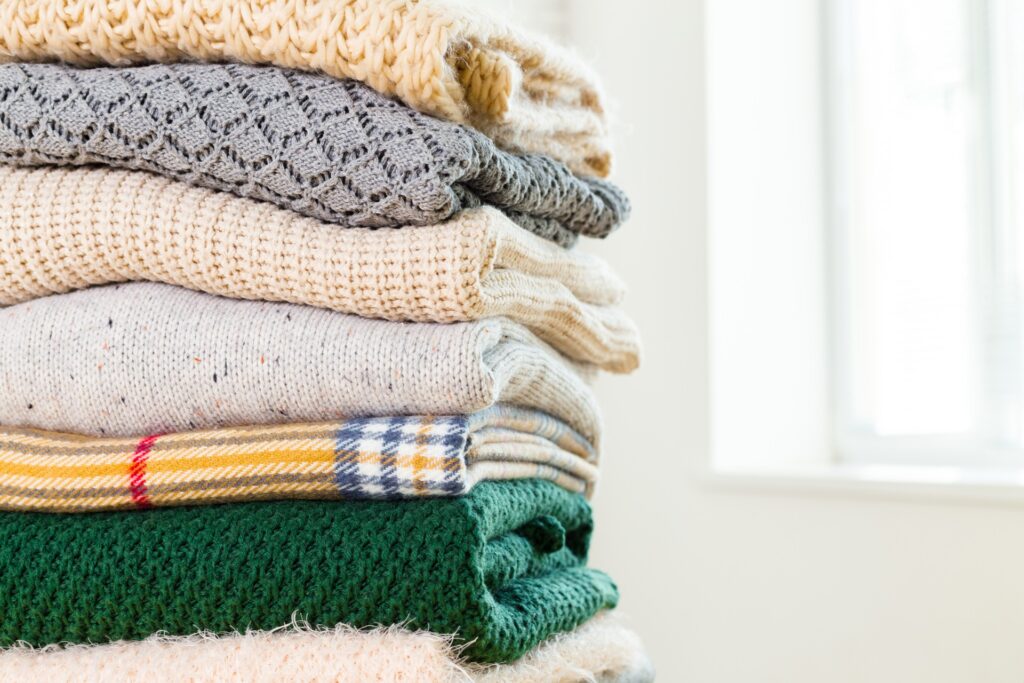Knitted clothes are a favorite for their cozy, stylish versatility, perfect for layering in winter or throwing over your shoulders on breezy summer evenings. If only they didn’t so easily stretch out, snag, or lose their shape because once they do, it’s hard to bring them back to their original look and fit. A stretched neckline or a few snags can quickly turn that sweater from chic to sloppy, making it feel worn out even if it’s still fairly new.
But with the right care, you can keep your knits looking fresh and fitted season after season. In this article, we walk you through some of the best practices of machine and hand washing knitted clothing items. We hope you find this information helpful!
How Knitwear Differs from Other Fabrics and Why It Needs Special Care
Knitted scarves, cardigans, or tank tops—these pieces have a unique charm and comfort that’s hard to beat. But knitwear isn’t like other fabrics. Knits are created by looping yarn together in a way that gives them stretch, softness, and that cozy feel we love. However, the flexibility that makes knitwear so comfortable also makes it more vulnerable to wear and tear. Let’s look into the reasons knits are so delicate and what makes them require special handling.Looped Structure
The looped construction of knitwear gives it that great stretch, but it also makes the fabric more susceptible to snags and pulls. Unlike woven fabrics, which are made by crossing yarns over and under each other, knits rely on a single continuous thread. This means if one loop is pulled, it can cause an entire section of the fabric to stretch or unravel.Fiber Types
Many knit pieces are made with natural fibers like wool, cotton, or cashmere, which are more prone to damage than synthetic fibers. These natural fibers are soft and breathable, but they can also shrink, stretch, or fade more easily. On the flip side, some knits made with synthetic fibers may be a bit more durable but can still suffer from pilling or stretching if not handled carefully.Pilling Potential
Pilling, those little fuzz balls that pop up on the surface of the fabric, is a common issue with knits. Since the fibers are loosely twisted, they tend to break with friction, causing tiny fiber balls to form. This happens more quickly when knits are exposed to rough surfaces or are tossed around in a washing machine without protection.Shape Retention
Knits have a natural elasticity that helps them fit well, but that same elasticity can lead to stretching out over time, especially if the garment is hung up or mishandled. Heavy sweaters or scarves are especially prone to losing their shape if not stored correctly, so they’re best kept folded rather than hung.Sensitivity to Water and Detergent
Knit fabrics, especially natural materials, are sensitive to water temperature and detergent type. Hot water or harsh laundry detergents can break down the fibers, causing shrinkage, fading, or weakening. A mild detergent and lukewarm water help prevent this type of damage.How to Properly Wash Knitted Clothes (For Both Machine and Hand Washing)
For knitted items like sweaters, scarves, and other cozy favorites, there’s a certain way you should wash them to keep the fibers intact and prevent stretching, fading, or damage. While some knits can handle the washing machine on a gentle cycle, others need the softer touch of hand washing. Below are some tried-and-true techniques for hand washing and machine washing knitwear:Hand Washing Knits
Hand washing is often the safest way to clean knits, especially for delicate pieces or those made from natural fibers like wool or cashmere. Here’s how to do it correctly:- Use Cold or Lukewarm Water – Cold or lukewarm water is gentle on knit fibers and helps prevent shrinkage or distortion. Hot water can break down the fibers, so it’s best avoided unless the care label says otherwise.
- Choose a Mild Detergent – Use a mild laundry detergent designed for delicate fabrics to prevent stripping the knit of its softness and color. Standard laundry detergents can be too harsh for knitwear and may cause the fabric to fade or weaken.
- Gently Soak and Squeeze – Place the knit item in the water and let it soak for about 10–15 minutes. Gently squeeze the fabric to work out any dirt or odor without scrubbing, which can damage the fibers. Avoid wringing out the water, as this can stretch and distort the knit.
Machine Washing Knits
Some knits, especially those labeled machine-washable, can handle a washing machine cycle as long as it’s washed carefully. If you decide to use a machine, here are some methods to protect your knits:- Use a Delicate or Wool Cycle – Most modern washing machines have a “delicate” or “wool” setting designed specifically for gentle washing of vulnerable fabrics. These cycles use less agitation and a shorter run time, which minimizes the risk of pilling and stretching.
- Turn Inside Out and Use a Mesh Bag – Turn your knit items inside out to reduce friction on the fabric’s outer layer. Placing them in a mesh laundry bag offers extra protection from the machine’s drum, which can cause friction and snagging.
- Wash with Similar Colors Only – Like any clothing, washing knits with similar colors helps avoid color transfer, especially with richly dyed items. Even on a gentle cycle, knit fabrics can be susceptible to bleeding, so keep lights and darks separate.

Storage Tips for Longevity
Like all garments, caring for knitted items doesn’t stop after washing. In fact, good storage practices are just as essential to keep them in top condition. Here are the proper ways of storing knitwears so they stay in great shape season after season:1. Always Fold, Don’t Hang
Hanging knits can lead to stretching, especially in heavier sweaters and scarves. Folding is the best way to store them, as it keeps the fibers from stretching out and preserves the garment’s original shape.2. Store in a Cool, Dry Place
Temperature and humidity matter when it comes to storing knitwear. A cool, dry environment protects against mold and mildew, while it also keeps the color from fading. Avoid storing knits in direct sunlight, as it can cause colors to fade or even weaken the fibers over time.3. Use Breathable Storage Bags for Long-term Storage
For off-season storage, place your knit items in breathable cotton or linen bags, which allow air to circulate and prevent moisture buildup. Avoid plastic bags, which trap humidity and can cause odor or discoloration. Breathable bags also make it easy to restore freshness with a quick airing out once the season changes.4. Add Natural Pest Repellents
Wool and other natural fibers can attract pests, such as moths. Use cedar blocks, lavender sachets, or other natural repellents in your storage area to keep insects at bay. These items add a pleasant scent to your storage space and help protect your knitwear from damage. With the proper storage techniques, your knitwear will stay in great shape, looking just as fresh as when it came out of the laundry, ready to be worn for years to come.Make Your Knits Last Season After Season with Columbus Dry Cleaning & Laundry Services!
Trust Columbus Dry Cleaning & Laundry Services for all your knitwear care and experience the service Central Ohio loves! Columbus Dry Cleaning & Laundry Services is proud to be one of Central Ohio’s top three dry cleaners. Whether it’s knitwear, leather, or specialty textiles, we have you covered with premium care that includes everything from stain removal to eco-friendly cleaning.
Columbus Dry Cleaning & Laundry Services offers a full suite of services: alterations and repair, household item cleaning, dry cleaning, laundry service, and even wedding dress and suede cleaning. We also offer free pickup and delivery service available across Central Ohio, including neighborhoods like Upper Arlington, Worthington, Powell, and beyond.
Get in touch with our customer service team at 614-588-5922 or email us at info@columbuscleaning.com.




